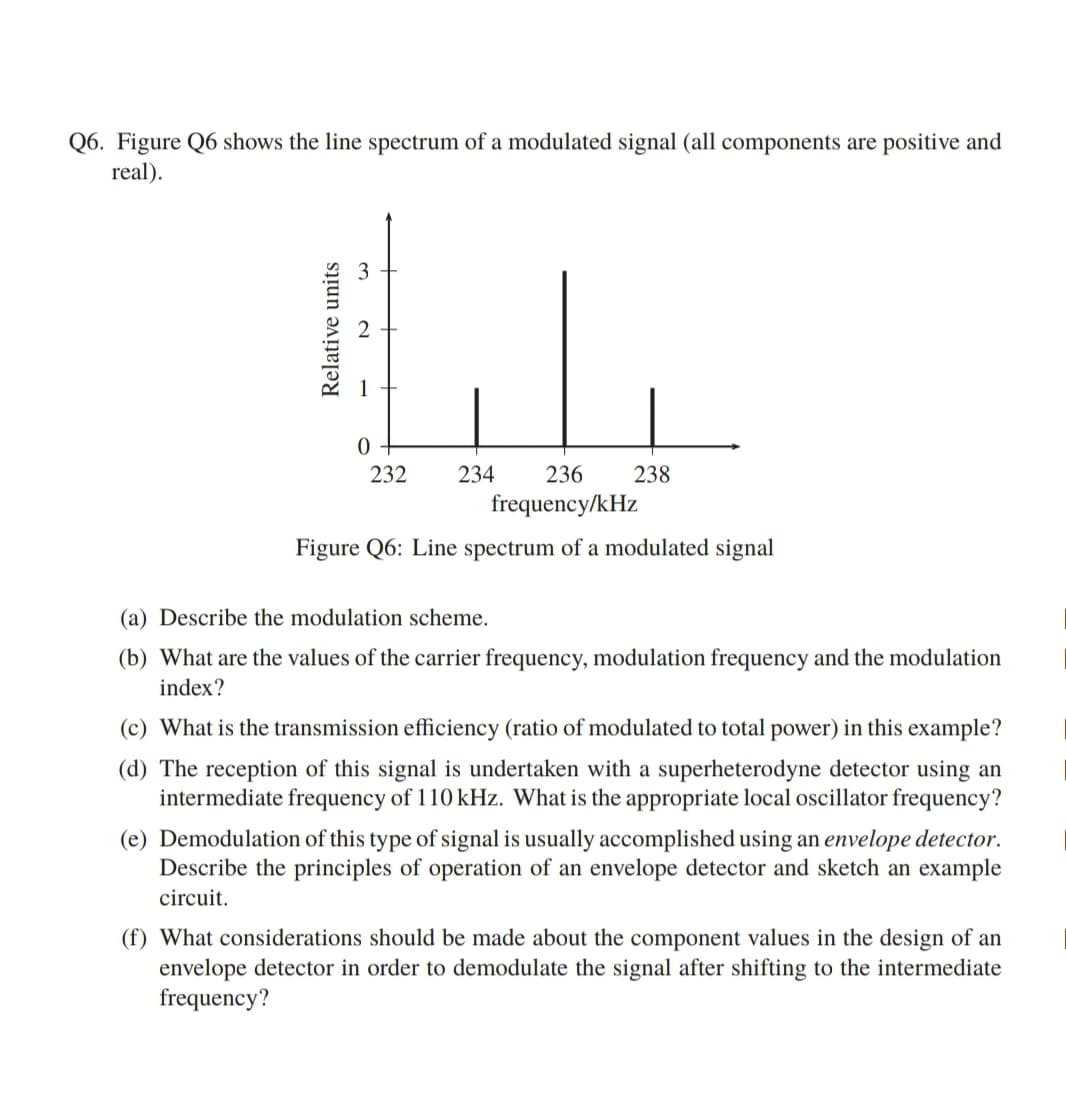Q6. Figure Q6 shows the line spectrum of a modulated signal (all components are positive and real). 1 232 234 236 238 frequency/kHz Figure Q6: Line spectrum of a modulated signal (a) Describe the modulation scheme. (b) What are the values of the carrier frequency, modulation frequency and the modulation index? (c) What is the transmission efficiency (ratio of modulated to total power) in this example? Relative units 2.
Q6. Figure Q6 shows the line spectrum of a modulated signal (all components are positive and real). 1 232 234 236 238 frequency/kHz Figure Q6: Line spectrum of a modulated signal (a) Describe the modulation scheme. (b) What are the values of the carrier frequency, modulation frequency and the modulation index? (c) What is the transmission efficiency (ratio of modulated to total power) in this example? Relative units 2.
Introductory Circuit Analysis (13th Edition)
13th Edition
ISBN:9780133923605
Author:Robert L. Boylestad
Publisher:Robert L. Boylestad
Chapter1: Introduction
Section: Chapter Questions
Problem 1P: Visit your local library (at school or home) and describe the extent to which it provides literature...
Related questions
Question

Transcribed Image Text:Q6. Figure Q6 shows the line spectrum of a modulated signal (all components are positive and
real).
3
1
232
234
236
238
frequency/kHz
Figure Q6: Line spectrum of a modulated signal
(a) Describe the modulation scheme.
(b) What are the values of the carrier frequency, modulation frequency and the modulation
index?
(c) What is the transmission efficiency (ratio of modulated to total power) in this example?
(d) The reception of this signal is undertaken with a superheterodyne detector using an
intermediate frequency of 110 kHz. What is the appropriate local oscillator frequency?
(e) Demodulation of this type of signal is usually accomplished using an envelope detector.
Describe the principles of operation of an envelope detector and sketch an example
circuit.
(f) What considerations should be made about the component values in the design of an
envelope detector in order to demodulate the signal after shifting to the intermediate
frequency?
Relative unitsS
Expert Solution
This question has been solved!
Explore an expertly crafted, step-by-step solution for a thorough understanding of key concepts.
Step by step
Solved in 3 steps with 2 images

Knowledge Booster
Learn more about
Need a deep-dive on the concept behind this application? Look no further. Learn more about this topic, electrical-engineering and related others by exploring similar questions and additional content below.Recommended textbooks for you

Introductory Circuit Analysis (13th Edition)
Electrical Engineering
ISBN:
9780133923605
Author:
Robert L. Boylestad
Publisher:
PEARSON

Delmar's Standard Textbook Of Electricity
Electrical Engineering
ISBN:
9781337900348
Author:
Stephen L. Herman
Publisher:
Cengage Learning

Programmable Logic Controllers
Electrical Engineering
ISBN:
9780073373843
Author:
Frank D. Petruzella
Publisher:
McGraw-Hill Education

Introductory Circuit Analysis (13th Edition)
Electrical Engineering
ISBN:
9780133923605
Author:
Robert L. Boylestad
Publisher:
PEARSON

Delmar's Standard Textbook Of Electricity
Electrical Engineering
ISBN:
9781337900348
Author:
Stephen L. Herman
Publisher:
Cengage Learning

Programmable Logic Controllers
Electrical Engineering
ISBN:
9780073373843
Author:
Frank D. Petruzella
Publisher:
McGraw-Hill Education

Fundamentals of Electric Circuits
Electrical Engineering
ISBN:
9780078028229
Author:
Charles K Alexander, Matthew Sadiku
Publisher:
McGraw-Hill Education

Electric Circuits. (11th Edition)
Electrical Engineering
ISBN:
9780134746968
Author:
James W. Nilsson, Susan Riedel
Publisher:
PEARSON

Engineering Electromagnetics
Electrical Engineering
ISBN:
9780078028151
Author:
Hayt, William H. (william Hart), Jr, BUCK, John A.
Publisher:
Mcgraw-hill Education,